On this page is a complete guide to guitar chord theory. You’ll learn concepts such as root notes, triad and seventh chord construction, diatonic and chromatic chords, and chord construction. You’ll also learn how to play many different types of chords.
Read this page to seriously improve your rhythm guitar playing and songwriting, whatever style of music you play!
Page Index
One of a guitarist’s main tasks is to accompany songs by playing chords, thereby providing both a harmonic and a rhythmic foundation for the music.
As a guitarist, you can get by simply by learning chord shapes and playing chords with appropriate strumming patterns.
However, learning about the theory behind chord construction will help both your guitar playing and songwriting / composition.
This page is intended to be a practical guide to chord theory, so we’ve added numerous examples throughout the page – keep a guitar handy to try out the example chords.
If you have any questions regarding the contents of this page, then feel free to ask in the comments section.
What Is A Chord?
A chord is a simply group of notes that is sounded simultaneously.
In music, chords can range from triads (simple three-note chords) to complex chords that contain many notes. (Whether two notes played together constitute a chord or simply an interval is a matter of debate).
A guitar is a polyphonic instrument (capable of playing multiple notes at the same time), but is limited to playing chords containing up to six notes, i.e. one note per string.
Chord Concepts
The following concepts will be explained on this page:
- Chords have a root note, and usually both a third and a fifth (although one or both of these may be omitted / substituted on occasion).
- The type of third (either a major third or a minor third) present in a chord determines whether it has a major or minor tonality.
- Sevenths are often added to chords to create major seventh, minor seventh, dominant seventh and other seventh chords.
- Additional notes can be added to chords to form suspended, added note, extended and altered chords.
- Chords are built from scales and can either be diatonic or chromatic.
The Notes In Guitar Chords
The notes in a guitar chord, and their relationship with the root note of the chord, determine the type (and sound) of the chord.
Root Note
The root note is the note that gives a guitar chord its name, i.e., the "C" in a C major chord, or the "B" in a B minor seventh chord. The other notes in the chord combine with the root note to give a chord its unique sound.
In the chord diagrams below, the root note is shown in blue. Note that in some chords, the root note is repeated in different octaves:

Chord Inversions
Most of the time, the root note of a guitar chord is the lowest note of the chord.
Chords in which the root note is not the lowest note are known as inversions. Using inverted chords can add interest to a guitar rhythm part, for example, by creating descending or ascending bass note lines.
In guitar chord symbols, inversions are depicted with a slash. See the "Slash Chords" section, further down the page, for more information.

Other Notes In Guitar Chords
The other notes in a guitar chord are identified by their interval relative to the root note of the chord.
Intervals
In music theory, an interval is how far apart two notes are from one another in pitch.
The numbers in guitar chord names/symbols are intervals. For example, the “7” in the chord symbol C7 refers to the interval a minor seventh above the root note of C, which is a B flat.
Some of the intervals used in guitar chord names and symbols are listed below:
| Number In Chord Symbol | Interval Name | Note With Root Note Of C |
|---|---|---|
| 2 | Major Second | D |
| 4 | Perfect Fourth | F |
| 5 | Perfect Fifth | G |
| 6 | Major Sixth | A |
| 7 | Minor Seventh | B Flat |
| Maj7 | Major Seventh | B |
| 9 | Compound* Major Second | D |
| 11 | Compound* Perfect Fourth | F |
| 13 | Compound* Major Sixth | A |
*A compound interval is an interval greater than an octave, formed by adding an octave to a simple interval.
A sharp symbol added before the number in a chord symbol increases that interval by a semitone. A flat symbol decreases the interval by a semitone. (See the Altered Dominants section, further down the page, for examples.)
Different Root Note; Same Type Of Chord
A chord containing the notes C, E, G, Bb is the same type of chord as one containing the notes D, F#, A, C. Both of these chords are dominant seventh chords (the first is a C seventh chord, the second is a D seventh chord).
Although (most of) the notes in the two chords are different, they are the same type of chord because both chords contain a root note, major third, fifth and minor seventh.
Moveable / Transposable Guitar Chords
This is how guitarists can get away with learning a single chord shape to play a particular type of chord with every root note!
By moving the same chord shape up and down the fretboard, all of the notes stay in the same position relative to the root note. Therefore, an A minor chord played at the 5th fret becomes a G minor chord when played at the 3rd fret, as shown below:
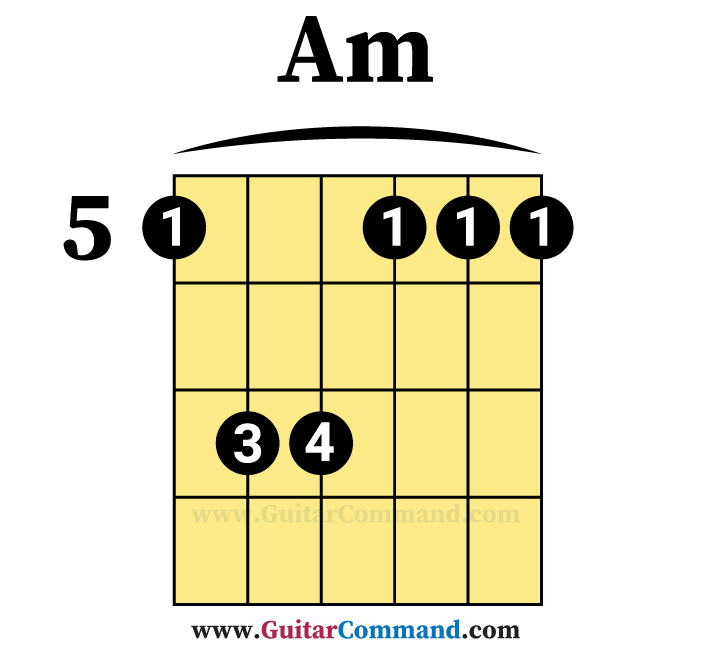
A guitar chord is only transposable in this way if it doesn't contain any open strings, as the open string notes would not change pitch relative to the root note!
Major And Minor Chord Tonality
Most chords contain either a major third or a minor third.
Major chords contain a major third (i.e. the note a major third above the root note). Minor chords contain a minor third (i.e. the note a minor third above the root note).
- The major third is the note four semitones away from the root note. In a chord with the root note of C, the major third is E.
- The minor third is the note three semitones away from the root note. In a chord with the root note of C, the minor third is E flat.


Play the chords below to hear how big a difference in sound moving just a single note one semitone can make!
In simple terms, major chords sound “happy”, and minor chords sound “sad”.

In most cases, a chord is a major (i.e., it contains a major third) unless specified. The chord symbol “E”, for example, means E major (an E minor chord has the symbol Em.)
Minor chords (i.e. those that contain a minor third) are usually specified by a lower case “m”, or by the abbreviation “min”. The symbols Cm and Cmin both refer to a C minor chord.
Chords Without A Third
Guitar chords that lack either a major or minor third are uncommon, and typically sound “ambiguous” or “expectant”. The most commonly used chords of this type are suspended, or “Sus” chords, which are discussed further down the page.
Triads And Sevenths
Triad and seventh chords are the building blocks of most rock and pop chord progressions. Triads and sevenths are built using the notes of major and minor scales, as explained in the section: The Relationship Between Keys, Scales And Chords, further down the page.
Triad Chords
A triad is a three-note chord consisting of a root note, third and fifth.
There are four types of triad: major, minor, diminished and augmented. They contain the following notes:
- Major triad: Root, Major Third, Perfect Fifth
- Minor triad: Root, Minor Third, Perfect Fifth
- Diminished Triad: Root, Minor Third, Diminished Fifth*
- Augmented Triad: Root, Major Third, Augmented Fifth**
*The interval of a diminished fifth is a semitone smaller than a perfect fifth. In a triad with the root note of C, the diminished fifth is a G flat.
**The interval of an augmented fifth is a semitone larger than a perfect fifth. In a triad with the root note of C, the augmented fifth is a G sharp.
Major and minor chords are the most common guitar chords (along with dominant seventh chords, which we'll get to soon). Although based on triad chords, guitar major and minor chords often repeat notes in multiple octaves to create a "bigger" sound (see below).
Diminished and augmented chords tend to be used less frequently, particularly without an added seventh.
Major Chords On Guitar
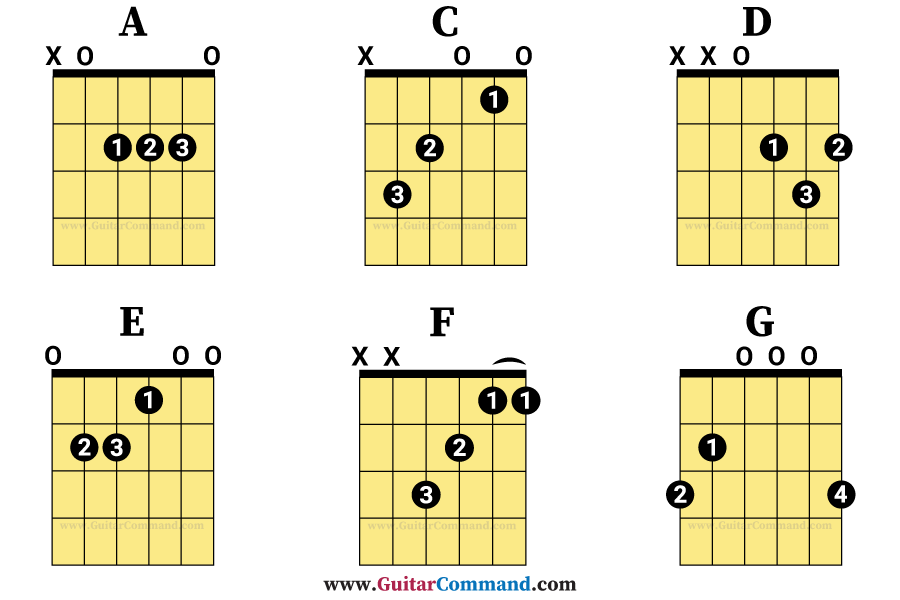
- Major chords contain three notes: root, major third, perfect fifth.
A guitar chord containing just the three notes of a major or minor triad would sound a little thin, and for this reason, guitar chords often contain the same note or notes repeated in multiple octaves.
In all of the major chords above, one or more of the root note, third or fifth has been repeated (in some cases, twice) in different octaves. In each of the chords above, can you work out which notes have been repeated, and their function (root / third / fifth) within the chord?
Repeating notes in this way gives a guitar chord a bigger and louder sound.
Minor Chords On Guitar
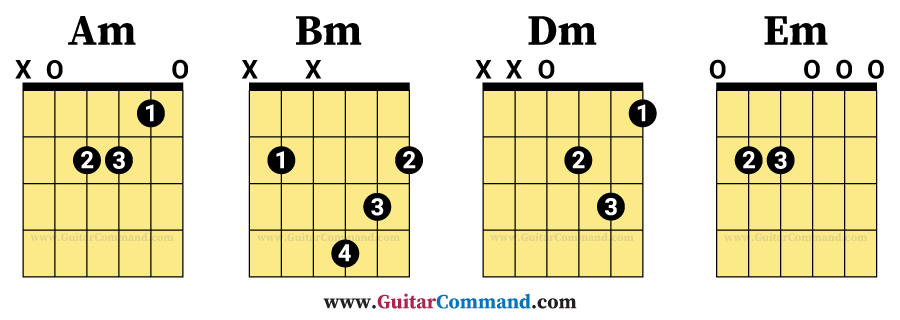
- Minor chords contain three notes: root, minor third, perfect fifth.
Minor guitar chords contain the three notes of a minor triad - root, minor third and fifth – usually with one or more of these notes repeated in different octaves.
Diminished And Augmented Triads
- Diminished triads are made up of the root note, the minor third and the flattened (diminished) fifth note.
The symbol for a diminished chord is a small circle.
- Augmented triads include the root note, the major third and the sharpened (augmented) fifth note.
The symbol for an augmented chord is a plus sign. A chord symbol that includes a plus sign shows that the chord has a sharpened (augmented) fifth, regardless of the other notes it contains.

Neither diminished nor augmented chords are played very frequently on guitar in their triad forms. The diminished is more often used when extended with a seventh note to make a diminished seventh chord (see below).
Seventh Chords
A seventh is a four-note chord consisting of a triad with either a minor or a major seventh. The additional seventh tone adds complexity to the pure sound of a triad.
Dominant Seventh Chord
A dominant seventh chord consists of a major triad and a minor seventh. Dominant seventh chords have the chord symbol “7”, therefore, a C dominant seventh chord’s symbol is C7.
A C dominant seventh chord contains the following notes: C, E, G, B flat.
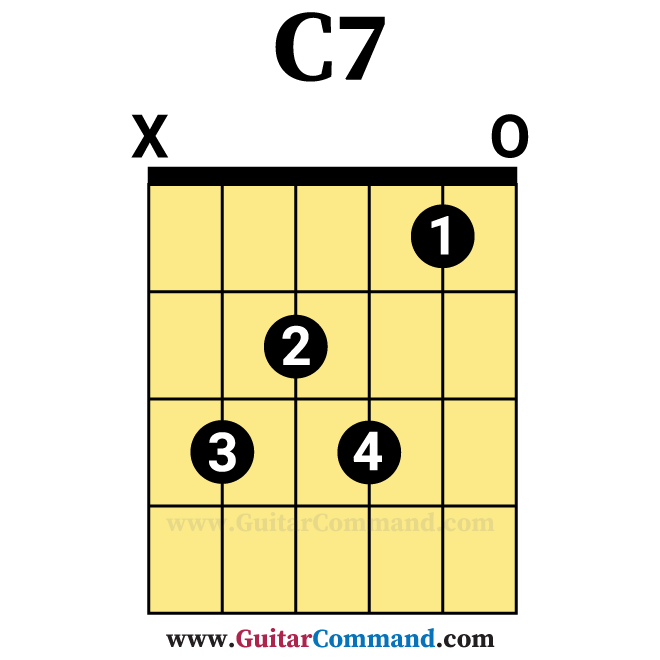
In the chord shape above, the root note (C) is played at the 3rd fret of the 5th string, and repeated at the 1st fret of the 2nd string.
The major third (E) is played at the 2nd fret of the 4th string and repeated with the open top E string.
The minor seventh note (B flat) is played at the 3rd fret of the 3rd string.
Note that, in the above chord shape, the fifth note (which would have been a G) has been omitted. The fifth note is often omitted in seventh (and other) guitar chords, as its presence (or lack of) has little bearing on the overall sound of the chord.
Dominant seventh notes are usually built on the fifth degree (known as the dominant note) of a scale. Dominant seventh chords have an expectant sound, and want to resolve to the tonic chord (i.e. the chord built on the first degree, or tonic note, of the scale).
You can hear this yourself by playing a G7 chord followed by a C chord. The G7 sounds expectant, and acts to introduce the C chord, which sounds stable.
Minor Seventh Chord
Minor seventh chords have an interesting, dark sound, perfect for minor blues or jazz-rock progressions.
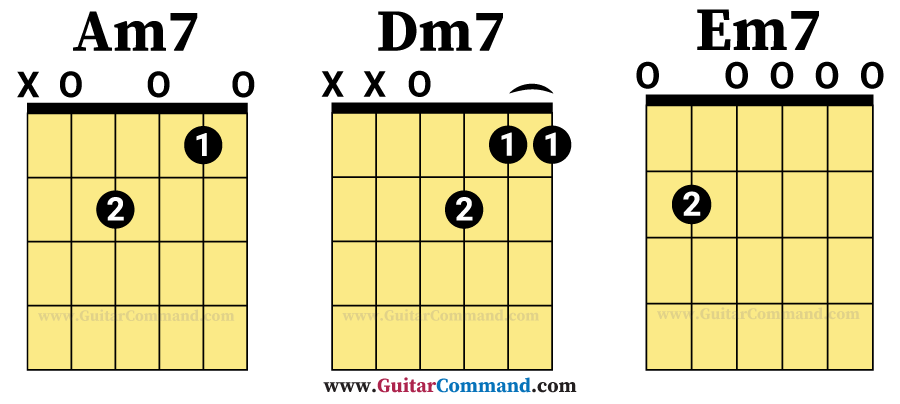
Minor seventh chords contain four notes: The root, minor third, fifth and minor seventh.
A C minor seventh chord (symbol Cm7) contains the notes: C, E flat, G, and B flat.
Major Seventh Chord
Often used in place of standard major chords, particularly in jazz, major seventh chords have a warm sound that can add interest to major chord progressions.
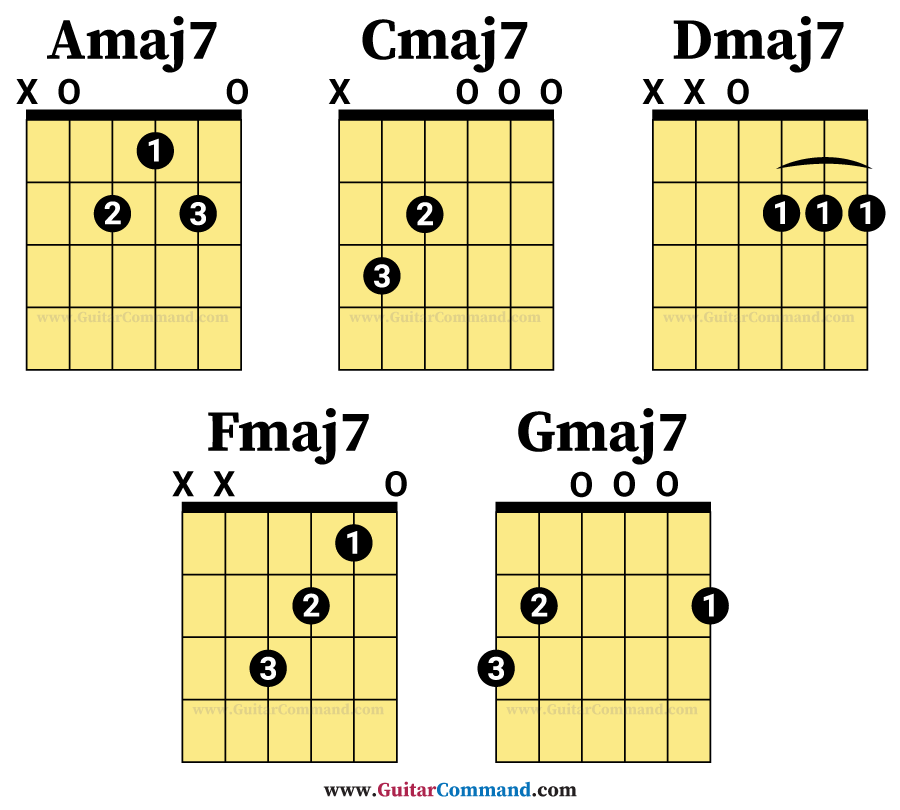
A major seventh chord contains four notes: The root, major third, fifth and major seventh.
A C major seventh chord (symbol Cmaj7) contains the notes: C, E, G, and B.
Diminished Seventh Chord
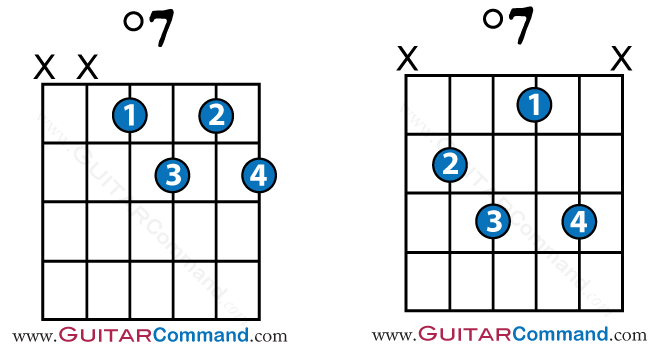
Diminished triads are often extended to include the diminished seventh (the note a minor third above the diminished fifth); these chords are known as diminished sevenths.
An interesting feature of diminished seventh chords is that any of the notes contained within the chord could potentially be the root note. Therefore, there are only three diminished seventh chords!
A C diminished seventh chord contains the notes: C, E flat, G flat and B double flat
Half-Diminished Seventh Chord

A half-diminished seventh chord is a diminished triad with an added minor seventh. This type of chord is often used as the ii chord in minor ii V I chord progressions.
A C half-diminished seventh chord contains the notes: C, E flat, G flat and B flat
The Relationship Between Keys, Scales And Chords
In general, the scale used in a piece of music determines the key in which the music is in.
Chords built from that scale are known as diatonic chords. Chords that use notes from other scales (and therefore, other keys) are known as chromatic chords.
For example, a piece in C major would use the notes of a C major scale: C, D, E, F, G, A, B, and chords in the key of C are constructed from those notes.
Chromatic chords are introduced into chord progressions to provide harmonic interest or to introduce a key change.
Chord Construction
Each of the notes in a scale can be used as the root note in a chord, and the third and fifth added to create a triad, as shown below (note that, from the G upwards, the notes "loop" back to the start of the scale).
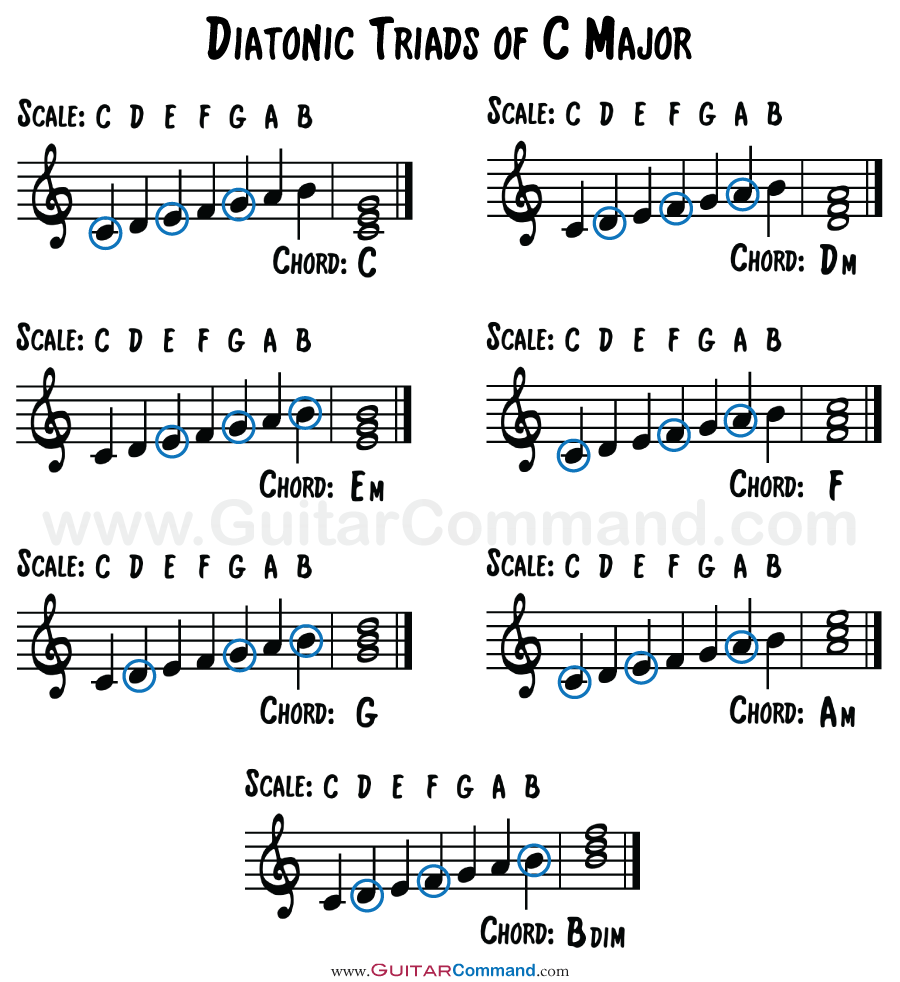
Every Triad And Seventh In The Key Of C Major


- You can see more information on how chords are constructed from major scales on this page: Diatonic Chords
- You can see how chords are constructed from minor scales on this page: A Minor Chords
Roman Numeral Chord Names
Triads and sevenths can be built using any of the notes of a scale as a root note, as shown above. Chords are often numbered depending on which note of the scale is their root note.
For example, the triad build on the first note of a major scale is given the number “I” (Roman numerals are used in chord numbering), the seventh built on the fifth degree of a major scale is known as the “V7”.
Major chords are usually written in uppercase letters (e.g. I, IV, V7); minor chords in lower case (e.g. ii, vi).
Referring to chords in this way means that music can be analysed without having to refer to a particular key.
For example, the common chord progression of a minor seventh built from the second degree of the scale, followed by the dominant seventh of the fifth note of the scale, followed by the major chord built on the first note of the scale is known as ii7, V7, I.
You can find out more about the “two five one” progression on this page: Two-Five-One-Progression-Explained
The Order Of Notes In Guitar Chords
In general, it doesn’t matter too much how the constituent notes of a guitar chord are arranged within the chord, unless the chord is a focal part of the music (for example, jazz guitarists use a technique called "Voice Leading" to create smooth-sounding chord progressions. You can find out more about this technique on this page: Introduction To Voice Leading On Guitar.)
Both of the guitar chords below are C7 chords and therefore contain the notes C, E, G, and B flat, but the order in which the notes are arranged are different.

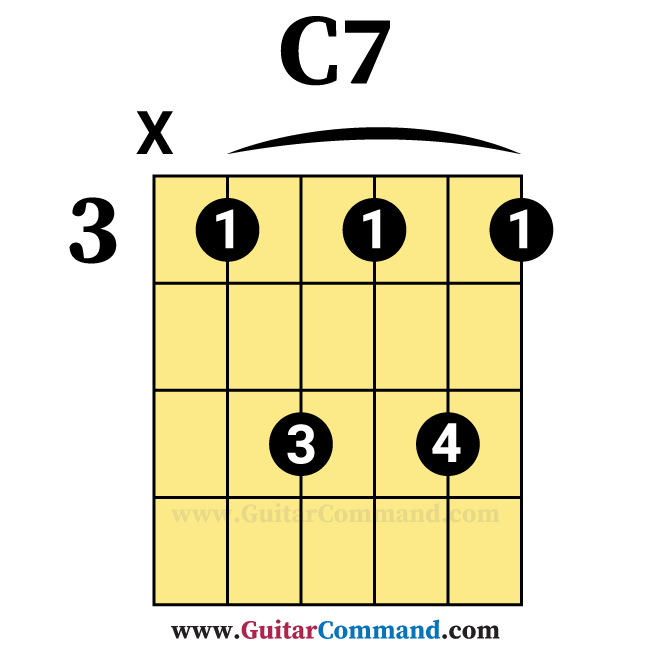
How notes are arranged in a guitar chord can have a bearing on how the chord sounds, but so long as all of the constituent notes are present, the chord name will generally remain the same, especially if the root note of the chord is the lowest note.
Chord Synonyms
However, some chords have synonyms, which means that the same notes could be given a different name.
For example, a chord containing the notes C, E, G, and A would normally be called a C added sixth (C6 or Cadd6), but could also be called an A minor seventh chord (Am7). How the notes are arranged within the chord, and the chord’s position within a chord progression, would determine its name.
You can find out more about chord synonyms on this page: Major 6th Chord Synonyms
Extended Chords
An extended chord is a dominant seventh chord onto which additional notes – one or more of the ninth, eleventh and thirteenth – have been added.
The fifth is often omitted from extended chords, as, unless it has been altered (see the Altered Chords section, further down the page) the fifth doesn’t have much bearing on the overall sound of the chord.
Extended chords can be played in the place of standard dominant 7th chords to produce a more interesting, jazzy, sound.
Ninth Chords
A ninth chord, symbol “9” consists of a dominant seventh with an added ninth note. A C ninth chord (C9) contains the notes: C, E, G, Bb, D.

Eleventh Chords

An eleventh chord, symbol “11” consists of a ninth with an added eleventh note. A C eleventh chord (C11) contains the notes: C, E, G, Bb, D, F.
Both the fifth and / or the ninth are often omitted from eleventh chords.
Thirteenth Chords

A thirteenth chord, symbol “13” consists of an eleventh chord with an added thirteenth note. A C thirteenth chord (C13) contains the notes: C, E, G, Bb, D, F, A.
One or more of the fifth, ninth and eleventh notes are often omitted from thirteenth chords.
Altered Dominant Chords
An altered dominant chord is a dominant chord in which one or more of the fifth, ninth, eleventh or thirteenth notes has either sharpened or flattened.
Examples of altered dominant chords include seventh sharpened fifth (7#5) and seventh flattened ninth (7b9).
Altered dominant chords have a very jazzy sound, and are often used as V chords in jazz music.

Notes in a C seventh sharpened fifth (C7#5) chord: C, E, G#, Bb
Notes in a C seventh flattened ninth (C7b9) chord: C, E, G, Bb, Db

Slash Chords
Chords can be played as inversions, which is when a note other than the root note is used as the bass note of the chord.
Slash chord symbols are in two parts, separated by a slash. The first part of a slash chord shows the chord to be played; the second part shows the bass note that should be added.
Sometimes the bass note is already part of the chord, in which case the slash chord is showing an inverted chord (e.g. C/G, in which G is already part of a C major chord).
At other times the slash chord adds a note to the chord. For example, the slash chord Dm/C is a D minor chord with a bass note of C. This chord would actually be an inverted Dm7 chord (in third inversion).
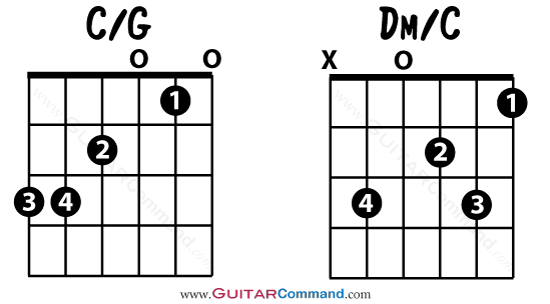
Suspended And Added Chords
Suspended / Sus Chords
In guitar chord theory, a suspended, or “sus” chord is one whose third has been replaced by either a perfect fourth or a major second.
In a sus2 chord, the third is replaced with the second.
In a sus4 chord, the third (either major or minor) is replaced with the fourth.
- Notes in a D sus2 chord: D, E, A
- Notes in a D sus4 chord: D, G, A

Added / “Add” Chords
Added, or "add" chords are major or minor chords with additional notes. The most common added chord is an add9, which is a major chord with a ninth added to it.
Added ninth chords contain the following notes: Root, Major Third, Perfect Fifth, Major Ninth.
- Notes in a C major chord: C E G
- Notes in a Cadd9 chord: C E G D
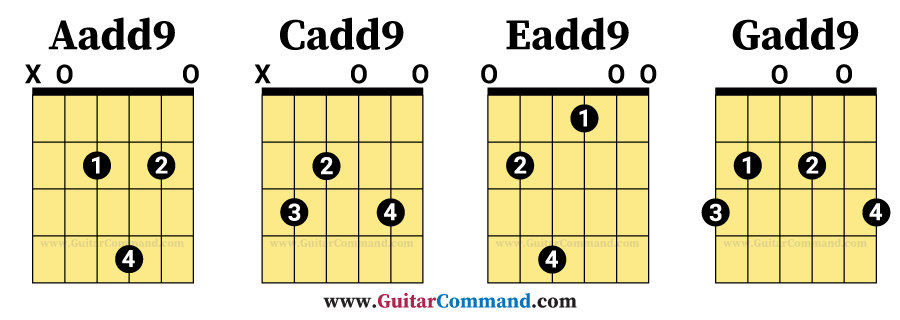
Sixth Chords
Sixth chords are essentially added chords, and can also be called added sixth chords. A major sixth chord (often just called a sixth chord) consists of a major triad with an added major 6 note. A minor sixth chord consists of a minor triad with an added major 6 note.
Sixth chords contain the following notes: Root, Major Third, Perfect Fifth, Major Sixth.
Minor sixth chords contain the following notes: Root, Minor Third, Perfect Fifth, Major Sixth.
- Notes in a C 6th chord: C E G A
- Notes in a C minor 6th chord: C Eb G A
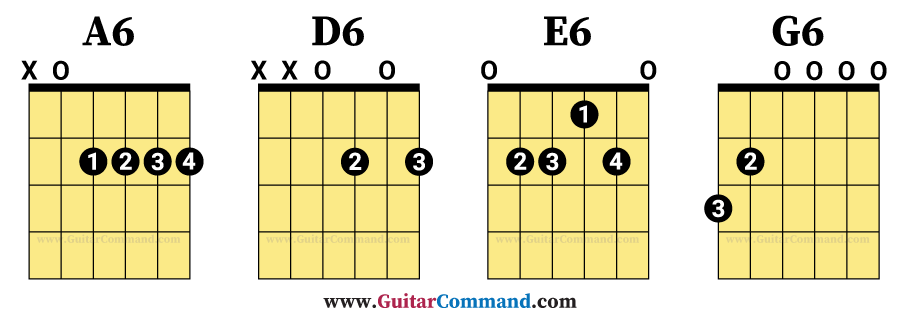
You can find out more about 6th chords on this page: Guitar Sixth Chords
The dissonance in added ninth chords and sixth chords can be very pleasing to the ear. Either of these chords can be used to replace standard major chords when a more colorful sound is required.
Guitar Chord Theory Conclusion & Further Readin
If you've made it this far, congratulations. Learning guitar chord theory is a challenge, but worthwhile if you want to gain a broader picture of how music works.
Now you have a better understanding of how guitar chords are constructed, try to use this knowledge in your rhythm guitar playing and songwriting.
You can find out more about guitar chords on the following pages:
- Diatonic Chords: What They Are & Why You Should Know Them
- A Minor Chord Progressions, Examples With Guitar Chords
- Chords In A Minor: Am Key Chords For Songwriters & Composers
- Learning More Advanced Guitar Chords
- Open Chords For Guitar: Diagrams For All Open Position Chords
- How To Play Chords On Guitar
- Jazz Guitar Chords



Interval sizes enhance understanding when describing intervals. (e.g. in your chart displaying the interval names for each pitch class on the C major scale.)
It’s a pleasure – thank you for your kind words.
Wow! Great information, great site! This is what the internet is all about. Cheers!
Very helpful, good information.